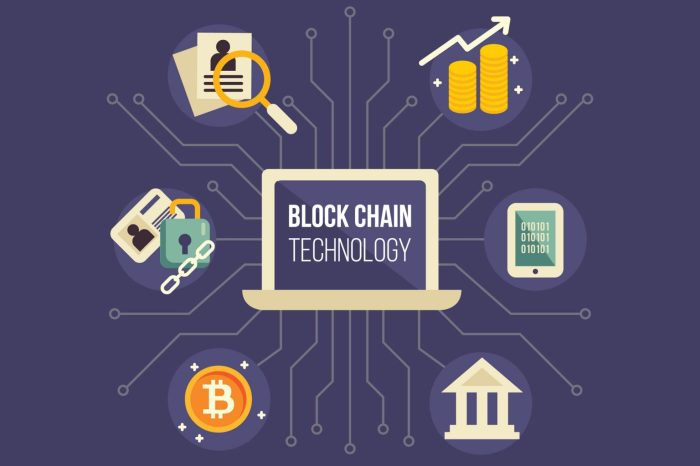
Blockchain security applications are at the forefront of revolutionizing how we protect our digital assets. With the increasing reliance on digital platforms, the significance of security in blockchain technology cannot be overstated. From securing sensitive financial transactions to protecting user data in mobile apps, the applications of blockchain in enhancing security are diverse and impactful.
This technology provides a decentralized approach that not only safeguards information but also fosters trust across various industries. Real-world examples illustrate how sectors like finance, content distribution, and the Internet of Things (IoT) are harnessing blockchain to fortify their security measures, making it an essential topic in today’s digital landscape.
Blockchain Security Applications Overview
The significance of security in blockchain technology cannot be overstated, as it ensures the integrity and trustworthiness of transactions across decentralized networks. In an era where data breaches and cyber threats are rampant, blockchain offers a robust solution to enhance security measures across various industries. Its unique characteristics, such as immutability and transparency, make it an ideal candidate for applications focused on safeguarding sensitive information.Blockchain’s applications in enhancing security span multiple sectors, providing innovative solutions to traditional security challenges.
By leveraging cryptographic techniques and decentralized consensus mechanisms, organizations can better protect their data and infrastructure from unauthorized access and fraud. The adaptability of blockchain technology allows it to be customized for different security needs, ranging from financial transactions to supply chain management.
Applications in Various Industries
Numerous industries have begun to harness the power of blockchain technology to improve security protocols. The following examples illustrate how blockchain is being applied in different sectors:
- Finance: Blockchain technology is widely used in the financial sector to secure transactions and reduce fraud. For instance, Ripple utilizes a decentralized ledger to facilitate cross-border payments securely and quickly, minimizing the risk of double-spending.
- Healthcare: In the healthcare industry, blockchain can securely store patient records and ensure data integrity. MedRec, for example, is a project that utilizes blockchain to manage electronic medical records, allowing for secure access while protecting patient confidentiality.
- Supply Chain: Blockchain enhances transparency and traceability in supply chains. IBM Food Trust uses blockchain to track food products from farm to table, ensuring safety and authenticity while preventing food fraud.
- Identity Management: Blockchain can improve identity verification processes. The Sovrin Network aims to provide individuals with self-sovereign identities, reducing identity theft and ensuring privacy through decentralized verification.
- Voting Systems: Voting processes can be secured using blockchain technology to prevent tampering and ensure transparency. Projects like Voatz have implemented blockchain for secure mobile voting, enhancing trust in electoral processes.
The versatility of blockchain technology and its security applications across various industries highlight its potential to redefine how data is protected and shared. With ongoing advancements, the integration of blockchain into security frameworks promises to provide even more innovative solutions to address emerging threats.
Web Hosting and Domain Names in Blockchain Security

The integration of blockchain technology into web hosting and domain name management presents significant advancements in security measures. Traditional systems often face vulnerabilities that can jeopardize domain ownership and web services. Blockchain offers a decentralized framework that enhances the integrity and security of web hosting solutions, creating a safer environment for digital assets and online activities.
Improving Domain Name Security with Blockchain
Blockchain technology improves domain name security primarily through its decentralized nature, which reduces the risk of single points of failure and attacks. Unlike traditional domain name systems (DNS) that are prone to hijacking, blockchain-based domain names are immutable and can be securely managed. This ensures that once a domain is registered, it cannot be altered without consensus from the blockchain network, significantly mitigating fraud risks.
Additionally, the transparent and cryptographically secure nature of blockchain ensures that all transactions related to domain ownership are recorded and verifiable.
Decentralized Web Hosting Solutions
Decentralized web hosting solutions leverage blockchain technology to distribute data across multiple nodes, enhancing both security and reliability. These solutions eliminate centralized servers, making it much more difficult for attackers to compromise services. Here are some key advantages of decentralized hosting:
- Resistance to Censorship: With no central authority controlling the content, decentralized hosting is less susceptible to censorship by governments or organizations.
- Enhanced Data Security: Data is stored in multiple locations, ensuring that even if one node fails or is compromised, the website remains accessible and intact.
- Improved Performance: Through distributed networks, decentralized hosting can optimize load times and reduce latency, as data is retrieved from the nearest node.
Comparison of Traditional Web Hosting and Blockchain-Based Hosting
When comparing traditional web hosting with blockchain-based hosting, there are notable differences in security measures. Traditional hosting relies on centralized servers, making them vulnerable to various cyber threats including Distributed Denial of Service (DDoS) attacks and server breaches. In contrast, blockchain hosting employs a decentralized approach, distributing data across numerous nodes, which not only enhances security but also improves redundancy.
Some critical differences include:
- Centralization vs. Decentralization: Traditional hosting is centralized and dependent on specific service providers, while blockchain hosting is decentralized, removing the reliance on single entities.
- Ownership Control: Blockchain technology allows users to retain full ownership and control over their domains and data, whereas traditional hosting often involves terms that could lead to loss of control.
- Security Protocols: Blockchain employs advanced cryptographic techniques, which provide greater security compared to conventional methods used in traditional hosting.
“The decentralized nature of blockchain enhances the resilience of web hosting solutions against attacks, ensuring higher uptime and improved security for users.”
Impact of Blockchain on Data Communication Security
Blockchain technology is fundamentally reshaping the landscape of data communication security. As organizations increasingly rely on digital channels for data exchange, the need for robust security measures becomes paramount. Blockchain’s decentralized and immutable nature provides a unique framework that enhances the security protocols governing data transmission, mitigating risks associated with traditional centralized systems.The integration of blockchain technology into data communication security protocols offers significant enhancements in protecting sensitive information.
By leveraging blockchain’s distributed ledger technology, organizations can achieve greater transparency and traceability in their data exchanges. This inherent security mechanism reduces vulnerabilities and potential points of attack, leading to more secure communication channels. Moreover, the blockchain framework supports various methods for securing data transmission, making it a valuable tool for organizations aiming to safeguard their data interactions.
Methods for Securing Data Transmission Using Blockchain Technology
Several innovative methods exist for securing data transmission through blockchain technology, each designed to enhance the overall security of data communication. These methods capitalize on the unique properties of blockchain to ensure that data remains protected throughout its transmission.One primary method involves the use of smart contracts, which are self-executing contracts with the terms directly written into code. Smart contracts can automate and enforce data exchange protocols, ensuring that only authorized parties have access to the data.
This automated verification process significantly reduces the opportunity for human error and malicious attacks.Another method focuses on the implementation of decentralized identity management systems. These systems allow individuals and organizations to maintain control over their digital identities, minimizing the risk of identity theft during data exchanges. By using blockchain to verify identities without relying on a central authority, the risk of data breaches is significantly reduced.Finally, blockchain enables the creation of secure communication channels utilizing cryptographic techniques.
Data can be encrypted before transmission, ensuring that even if intercepted, it remains unintelligible to unauthorized users. This encryption process is often complemented by public and private key infrastructure, where only designated recipients can decrypt the data, thereby enhancing confidentiality.
Role of Encryption and Authentication in Blockchain-Driven Data Communication
Encryption and authentication are cornerstones of blockchain-driven data communication security. They work in tandem to ensure that the integrity and confidentiality of data are maintained throughout the communication process.Encryption is vital in securing data as it transforms readable information into a coded format, making it unreadable to anyone who does not possess the decryption key. This ensures that sensitive data, such as personal information or financial transactions, remains protected from unauthorized access during transmission.
Blockchain’s inherent design supports advanced cryptographic algorithms, enhancing the security of the encryption process.Authentication, on the other hand, is essential for verifying the identity of parties involved in data communication. In a blockchain context, authentication mechanisms often employ digital signatures, which ensure that the data originated from a verified source. This process not only confirms the identity of the sender but also ensures the integrity of the transmitted data, as any alteration would invalidate the digital signature.In summary, the impact of blockchain on data communication security is profound.
By enhancing protocols through decentralized verification, implementing smart contracts, and utilizing encryption and authentication mechanisms, blockchain technology offers a robust framework for secure data transmission.
Security in E-Books and Digital Content
The rise of digital content has transformed how we consume literature, educational materials, and multimedia. However, with this transition comes the pressing concern of securing e-books and other digital content against unauthorized use and piracy. Blockchain technology has emerged as a promising solution, offering innovative methods for security and copyright protection that can benefit authors, publishers, and consumers alike.Blockchain technology can secure e-books through various methods that enhance accessibility while ensuring protection against unauthorized distribution.
By employing decentralized ledgers, transactions related to e-book sales and distribution can be recorded immutably, which promotes transparency and accountability. Additionally, using smart contracts, authors and publishers can establish specific terms of use that automatically enforce access restrictions, thereby preventing unauthorized sharing or modifications.
Methods of Securing E-Books with Blockchain Technology
To effectively secure e-books, several blockchain-based methods can be implemented. These methods not only enhance the security of the digital content but also streamline the distribution process for all stakeholders involved.
- Decentralized Ownership Records: Blockchain enables the creation of a decentralized database that records ownership and transaction history for e-books, ensuring that copyright ownership is unambiguous and traceable.
- Smart Contracts: By utilizing smart contracts, authors can automate the licensing process, enforcing copyright conditions directly within the e-book’s distribution model. This allows for real-time enforcement of payment and access rights.
- Digital Watermarking: Blockchain can be combined with digital watermarking to embed unique identifiers within e-books, making it easier to trace unauthorized copies back to their original sources.
- Tokenization: Authors can tokenize their works, creating unique digital tokens that represent ownership rights. This facilitates the sale and transfer of e-books while maintaining security and traceability.
Copyright Protection for Digital Content Creators
Copyright protection is crucial for digital content creators as it ensures that their intellectual property rights are safeguarded against infringement. Blockchain technology plays a significant role in enhancing copyright protection by establishing a secure and transparent framework for rights management.The use of blockchain can guarantee that creators maintain control over their work through the following mechanisms:
- Immutable Copyright Registration: Blockchain allows for the permanent registration of copyright, providing a tamper-proof record that proves the existence and ownership of the content at a specific time.
- Automatic Royalty Payments: Smart contracts facilitate automatic distribution of royalties to creators when their work is accessed or sold, ensuring authors receive fair compensation without intermediary delays.
- Global Accessibility: Blockchain operates on a global scale, allowing creators to secure their rights internationally, thus protecting their works from piracy and unauthorized usage across borders.
Secure Distribution Models for E-Books Using Blockchain
Secure distribution models leverage blockchain technology to enhance the safety and reliability of e-book transactions. These models ensure that the process of accessing and sharing digital content is both user-friendly and secure.Important aspects of secure distribution models include:
- Peer-to-Peer Distribution: Through a decentralized network, e-books can be distributed directly between users, reducing the risk of piracy and ensuring that authors receive their due compensation.
- Access Control Mechanisms: Blockchain can enforce strict access controls, allowing creators to define who can view, share, or modify their content, thus preventing unauthorized use.
- Integration with Digital Libraries: Blockchain can be integrated with digital libraries to create a secure ecosystem where e-books can be borrowed and lent with verified rights management, enhancing access while protecting ownership.
Enhancing Mobile Computing Security with Blockchain
As mobile computing continues to evolve, so does the need for robust security measures. Blockchain technology offers innovative solutions to enhance the security of mobile applications, ensuring user data remains safe from vulnerabilities. The decentralized nature of blockchain presents unique advantages for protecting sensitive information on mobile devices.Blockchain technology has significant implications for mobile app security. By providing a decentralized framework, it eliminates single points of failure that traditional systems often encounter.
Each transaction on a blockchain is cryptographically secured and immutable, making unauthorized access extremely difficult. Furthermore, the consensus mechanism integral to blockchain ensures that all network participants validate transactions, thus adding an additional layer of security against fraudulent activities.
Protection of User Data in Mobile Computing Devices
The ability of blockchain to safeguard user data in mobile computing is paramount, especially in an era where data breaches are increasingly common. Utilizing blockchain, developers can implement solutions that enhance privacy and data integrity. Here are key points on how blockchain effectively protects user data:
-
Decentralization:
User data is not stored on a central server, reducing the risk of large-scale data breaches. Instead, information is distributed across the blockchain network, making it less accessible to hackers.
-
Encryption:
Data stored on the blockchain is encrypted and can only be decrypted by authorized users, ensuring that sensitive information remains confidential.
-
Smart Contracts:
These self-executing contracts with the terms of the agreement directly written into code can automate and secure transactions without human intervention, minimizing errors and fraud.
-
Data Integrity:
The immutable nature of blockchain means that once data is recorded, it cannot be altered or deleted, providing a clear audit trail for every transaction.
Examples of Mobile Applications Utilizing Blockchain for Enhanced Security
Several mobile applications have successfully integrated blockchain to bolster their security features, providing users with tangible benefits. For instance, some notable applications include:
-
Everledger:
This app uses blockchain technology to securely track the provenance of high-value assets like diamonds and fine wine. By recording each transaction on the blockchain, Everledger ensures authenticity and protects against fraud.
-
Myco:
A mobile app designed for secure communication, Myco employs blockchain to encrypt messages, giving users the assurance that their conversations are private and tamper-proof.
-
Uphold:
As a digital wallet, Uphold leverages blockchain for secure transactions, allowing users to manage multiple currencies while ensuring their financial data remains protected through advanced cryptography.
-
Wibx:
This platform allows users to exchange goods and services using Wibx tokens. By recording transactions on a blockchain, it enhances security and trust among users, fostering a decentralized marketplace.
Blockchain in Software Development Security

The advent of blockchain technology has transformed various sectors, including software development. With its unique architecture and decentralized nature, blockchain presents both new opportunities and security challenges. As developers embark on creating blockchain applications, the importance of secure coding practices cannot be overstated. Ensuring that security is baked into the development process is crucial for maintaining the integrity and trustworthiness of blockchain solutions.Secure coding practices are vital in blockchain software development as vulnerabilities can lead to significant security breaches, loss of assets, and damage to reputation.
The decentralized and immutable nature of blockchain means that once a vulnerability is exploited, it can be challenging to reverse or remedy the situation. Developers must prioritize adopting secure coding standards and implementing thorough testing protocols to safeguard their applications from potential threats.
Strategies for Auditing Blockchain Code
Conducting regular audits of blockchain code is essential for identifying and mitigating vulnerabilities before they can be exploited. A proactive approach to code auditing helps ensure that software remains secure throughout its lifecycle. Important strategies for auditing blockchain code include the following:
Code Review
Regular peer reviews of the codebase help in identifying security flaws and coding errors early. Involving developers with diverse expertise can provide valuable insights.
Automated Security Testing
Utilizing automated tools to test for common vulnerabilities, such as those Artikeld in the OWASP Top Ten, can streamline the auditing process and increase efficiency.
Static and Dynamic Analysis
Implementing both static and dynamic analysis tools allows for comprehensive testing. Static analysis reviews the code without executing it, while dynamic analysis tests the code during runtime, uncovering potential security issues.
Vulnerability Scanning
Employing vulnerability scanning tools specifically designed for blockchain applications can help identify known vulnerabilities and weaknesses in the code.
Bug Bounty Programs
Engaging the community through bug bounty programs incentivizes ethical hackers to find and report vulnerabilities, contributing to the overall security of the application.
Tools and Frameworks for Enhancing Security
Various tools and frameworks are available to enhance security in blockchain software development, facilitating secure coding and effective auditing. The following tools exemplify this commitment to security:
Mythril
A security analysis tool for Ethereum smart contracts, Mythril enables developers to perform static analysis and identify security vulnerabilities in their contracts.
Slither
This static analysis framework for smart contracts provides insights into potential security issues and optimization opportunities, helping developers write better code.
Truffle Suite
An integrated development environment for Ethereum, Truffle includes built-in security features that assist developers in creating secure smart contracts.
OpenZeppelin
A library of reusable and secure smart contract components, OpenZeppelin helps developers follow best practices and standards for blockchain security.
SonarQube
This tool provides continuous inspection of code quality and security vulnerabilities, aiding in maintaining secure coding practices throughout the development process.By leveraging these tools and adhering to robust auditing strategies, developers can significantly enhance the security of their blockchain applications, ensuring they remain resilient against evolving threats.
Gadgets and IoT Security with Blockchain
In an increasingly connected world, the Internet of Things (IoT) is transforming daily life through smart gadgets and devices. However, with this connectivity comes heightened security risks. Blockchain technology offers a promising solution to enhance the security of IoT devices, ensuring data integrity and user trust.Blockchain secures IoT devices by providing a decentralized and immutable ledger that records transactions across a distributed network.
This eliminates the need for a central authority, which can be a single point of failure. Each IoT device can be assigned a unique identity on the blockchain, allowing for secure communication and authentication. The use of smart contracts further automates processes and enhances security by enforcing rules without human intervention.
Challenges of Securing Gadgets in a Connected Environment Using Blockchain
Despite the advantages, there are significant challenges to implementing blockchain for IoT security. These challenges include scalability, energy consumption, and integration with existing systems. The decentralized nature of blockchain can lead to slower transaction speeds, which may not be suitable for real-time IoT applications. Additionally, the energy demands of blockchain networks can be high, especially when considering the operational constraints of many IoT devices.Security challenges also arise from the diverse range of IoT devices, each with varying capabilities and security requirements.
Ensuring uniformity in security protocols across different gadgets can be complex, and any vulnerability in a single device can compromise the entire network.
Examples of IoT Platforms Incorporating Blockchain for Security
Several IoT platforms are leveraging blockchain to enhance security. These platforms demonstrate practical applications of blockchain technology in securing connected devices:
- IOTA: Designed specifically for IoT, IOTA uses a unique structure called the Tangle, which allows for feeless transactions and high scalability. This platform focuses on securing data transactions between devices without relying on traditional blockchain structures.
- IBM Watson IoT: IBM integrates blockchain to enhance the security of IoT solutions. It enables secure device authentication and ensures data integrity through a decentralized ledger, allowing for trusted data sharing among devices.
- VeChain: This platform focuses on supply chain and logistics, utilizing blockchain to secure data from IoT devices. VeChain ensures the authenticity of products and their journey through the supply chain, enhancing transparency and security.
Blockchain technology empowers IoT devices with a secure, decentralized framework that mitigates risks associated with centralized systems.
Final Thoughts
In summary, blockchain security applications are reshaping the way we think about data integrity and protection. As we have explored various use cases and implications, it becomes clear that adopting blockchain technology is not merely an option but a necessity for enhancing security in an increasingly interconnected world. The future of security lies in leveraging these innovative solutions to build a safer digital ecosystem for everyone.
Clarifying Questions
What are blockchain security applications?
Blockchain security applications are tools and solutions that utilize blockchain technology to enhance the security of digital transactions, data communication, and asset protection.
How does blockchain improve domain name security?
Blockchain improves domain name security by preventing unauthorized access and enabling a decentralization model that makes it harder to hijack domain names.
Can blockchain secure IoT devices?
Yes, blockchain can secure IoT devices by creating a secure communication framework that authenticates devices and prevents unauthorized data access.
What role does encryption play in blockchain security?
Encryption in blockchain security ensures that data is securely transmitted and stored, preventing unauthorized parties from accessing sensitive information.
Are blockchain security applications scalable?
Yes, blockchain security applications can be scalable, allowing them to adapt to increased data loads and user demands across various industries.




